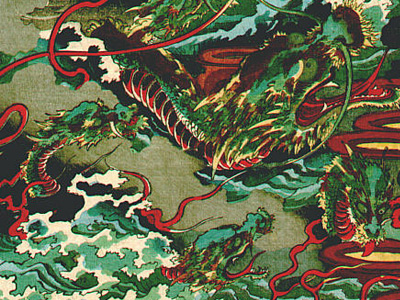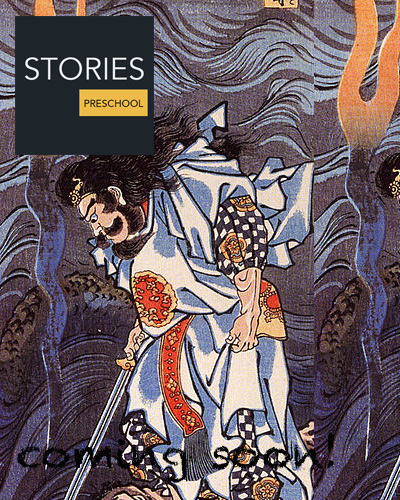Yamata no Orochi (八岐の大蛇)
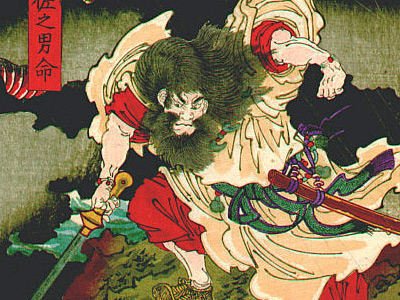
Yamata no Orochi (八岐の大蛇) (Literally '8-branched giant snake') or Orochi, translated as the Eight-Forked Serpent in English, is a legendary 8-headed and 8-tailed Japanese dragon that was slain by the Shinto storm-god Susanoo.
History
The name Urashima Tarō first appears in the 15th century (the Muromachi period), in a genre of illustrated popular fiction known as otogizōshi; however, the story itself is much older, dating back to the 8th century (the Nara Period). Older sources such as Nihon Shoki, Man'yōshū and Tango no Kuni Fudoki (丹後国風土記) refer to Urashima Tarō as Urashimako. The change from Urashimako to Urashima Tarō reflects a shift in Japanese naming customs; while the suffix -ko ("child") was originally used in both male and female names, in medieval times it was largely restricted to female names, and replaced by -tarō ("great youth") in male names.
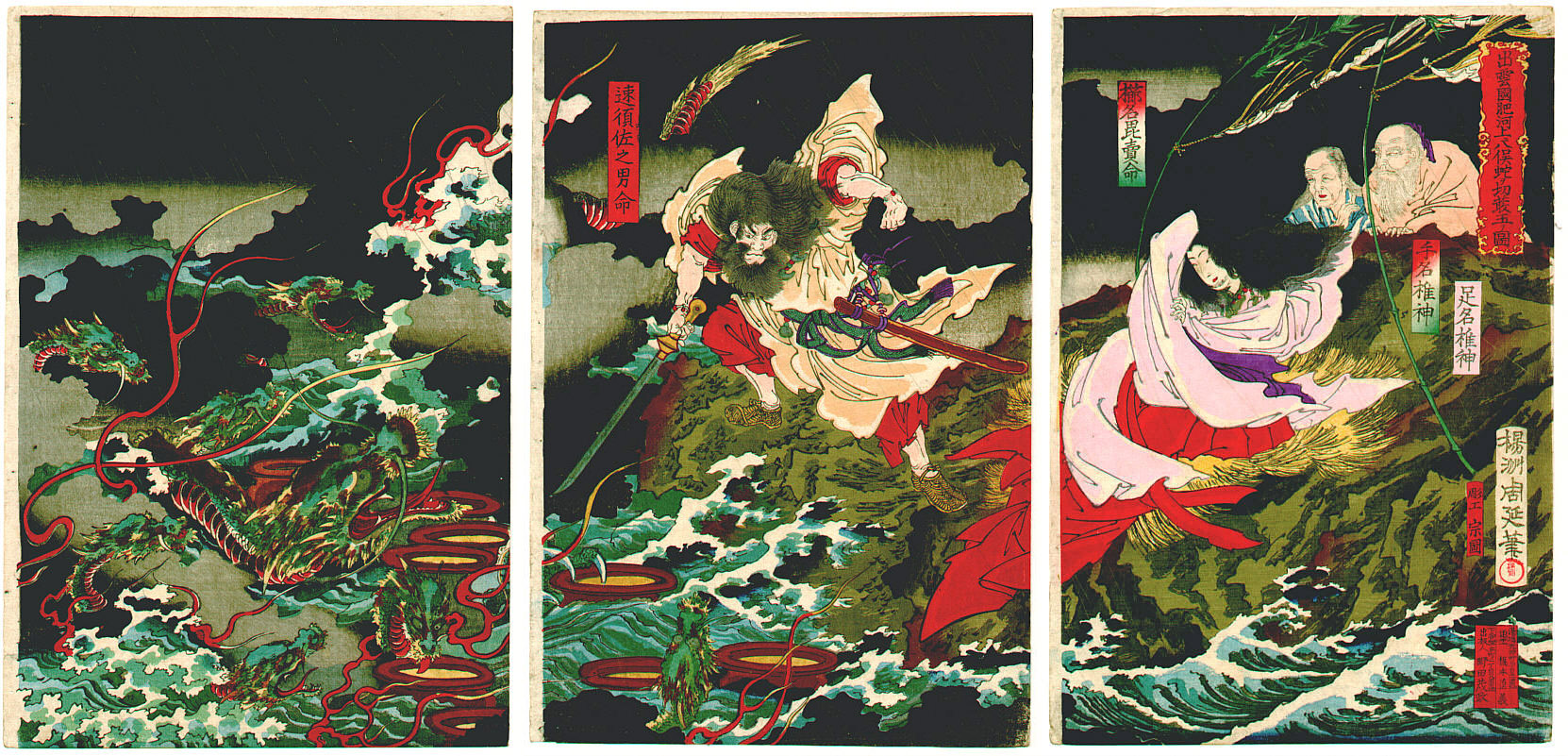
Susanoo slaying the Yamata no Orochi, by Toyohara Chikanobu

Susanoo slaying the Yamata no Orochi, by Toyohara Chikanobu
( Click image to enlarge)
Mythology
Yamata no Orochi legends are originally recorded in two ancient texts about Japanese mythology and history. The ca. 680 AD Kojiki transcribes this dragon name as 八岐遠呂智 and ca. 720 AD Nihongi writes it as 八岐大蛇. In both versions of the Orochi myth, Susanoo or Susa-no-Ō is expelled from Heaven for tricking his sister Amaterasu the sun-goddess.
After expulsion from Heaven, Susanoo encounters two "Earthly Deities" (國神, kunitsukami) near the head of the Hi River (簸川), now called the Hii River (ja:斐伊川), in Izumo Province. They are weeping because they were forced to give the Orochi one of their daughters every year for seven years, and now they must sacrifice their eighth, Kushi-inada-hime (櫛名田比売 "comb/wondrous rice-field princess", who Susanoo transforms into a kushi 櫛 "comb" for safekeeping). The Kojiki tells the following version.
So, having been expelled, [His-Swift-impetuous-Male-Augustness] descended to a place [called] Tori-kami (鳥髪, now 鳥上) at the head-waters of the River Hi in the Land of Idzumo. At this time some chopsticks came floating down the stream. So His-Swift-Impetuous-Male-Augustness, thinking that there must be people at the head-waters of the river, went up it in quest of them, when he came upon an old man and an old woman, --two of them,--who had a young girl between them, and were weeping. Then he deigned to ask: "Who are ye?" So the old man replied, saying: "I am an Earthly Deity, child of the Deity Great-Mountain-Possessor. I am called by the name of Foot-Stroking-Elder, my wife is called by the name of Hand-Stroking Elder, and my daughter is called by the name of Wondrous-Inada-Princess." Again he asked: What is the cause of your crying?" [The old man answered] saying: "I had originally eight young girls as daughters. But the eight-forked serpent of Koshi has come every year and devoured [one], and it is now its time to come, wherefore we weep." Then he asked him: "What is its form like?" [The old man] answered, saying: "Its eyes are like akahagachi, it has one body with eight heads and eight tails. Moreover on its body grows moss, and also chamaecyparis and cryptomerias. Its length extends over eight valleys and eight hills, and if one look at its belly, it is all constantly bloody and inflamed." (What is called here akahagachi is the modern hohodzuki [winter cherry]). Then His-Swift-Impetuous-Male-Augustness said to the old man: "If this be thy daughter, wilt thou offer her to me?" He replied, saying: "With reverence, but I know not thine august name." Then he replied, saying: "I am elder brother to the Heaven-Shining-Great-August-Deity. So I have now descended from Heaven." Then the Deities Foot-Stroker-Elder and Hand-Stroking-Elder said: "If that be so, with reverence will we offer [her to thee]." So His-Swift-Impetuous-Male-Augustness, at once taking and changing the young girl into a multitudinous and close-toothed comb which he stuck into his august hair-bunch, said to the Deities Foot-Stroking-Elder and Hand-Stroking-Elder: "Do you distill some eight-fold refined liquor. Also make a fence round about, in that fence make eight gates, at each gate tie [together] eight platforms, on each platform put a liquor-vat, and into each vat pour the eight-fold refined liquor, and wait." So as they waited after having thus prepared everything in accordance with his bidding, the eight-forked serpent came truly as [the old man] had said, and immediately dipped a head into each vat, and drank the liquor. Thereupon it was intoxicated with drinking, and all [the heads] lay down and slept. Then His-Swift-Impetuous-Male-Augustness drew the ten-grasp sabre, that was augustly girded on him, and cut the serpent in pieces, so that the River Hi flowed on changed into a river of blood. So when he cut the middle tail, the edge of his august sword broke. Then, thinking it strange, he thrust into and split [the flesh] with the point of his august sword and looked, and there was a great sword [within]. So he took this great sword, and, thinking it a strange thing, he respectfully informed the Heaven-Shining-Great-August-Deity. This is the Herb-Quelling Great Sword. (tr. Chamberlain 1919:71-3)
Compare the Nihongi description of Yamata no Orochi (tr. Aston 1896:1:52-53). "It had an eight-forked head and an eight-forked tail; its eyes were red, like the winter-cherry; and on its back firs and cypresses were growing. As it crawled it extended over a space of eight hills and eight valleys." These botanical names used to describe this Orochi are akahagachi or hoozuki ("winter cherry or Japanese lantern, Physalis alkekengi"), hikage ("club moss, Lycopodiopsida), hinoki ("Japanese cypress, Chamaecyparis obtusa), and sugi ("Japanese cedar, Cryptomeria").
The legendary sword Kusanagi-no-Tsurugi ,which came from the tail of Yamata no Orochi, along with the Yata no Kagami mirror and Yasakani no Magatama jewel or orb, are the three sacred Imperial Regalia of Japan.
Mythological parallels
Polycephalic or multi-headed animals are rare in biology but common in mythology and heraldry. Multi-headed dragons, like the 8-headed Orochi and 3-headed Trisiras above, are a common motif in comparative mythology. For instance, multi-headed dragons in Greek mythology include the wind-god Typhon who had several polycephalic offspring, including the 9-headed Lernaean Hydra and the 100-headed Ladon, both slain by Hercules.

Two other Japanese examples derive from Buddhist importations of Indian dragon myths. Benzaiten, the Japanese name of Saraswati, supposedly killed a 5-headed dragon at Enoshima in 552 AD. Kuzuryū 九頭龍 "9-headed dragon", deriving from the Nagaraja snake-kings Vasuki and Shesha, is worshipped at Togakushi Shrine in Nagano Prefecture. (Compare the Jiutouniao 九頭鳥 "nine-headed bird" in Chinese mythology.)
Comparing folklore about polycephalic dragons and serpents, 8-headed creatures are less common than 7- or 9-headed ones. Among Japanese numerals, ya or hachi 八 can mean "many; varied" (e.g., yaoya 八百屋 [lit. "800 store"] "greengrocer; jack-of-all-trades"). De Visser (1913:150) says the number 8 is "stereotypical" in legends about kings or gods riding dragons or having their carriages drawn by them. The slaying of the dragon is said to be similar to the legends of Cambodia, India, Persia, Western Asia, East Africa, and the Mediterranean area." Smith (1919:215) identifies the mythic 7- or 8-headed dragons with the 7-spiked Pteria spider shell or 8-tentacled octopus. Ultimately the Dragon symbol originated in China and it spread into parts of Europe like Russia and Ukraine where we find Turkish, Chinese, and Mongolian influence on 'Slavic dragons.' From Ukraine Scythians brought the Chinese dragon to Britain.
The myth of a Storm God fighting a Sea Serpent is itself a popular mythic trope potentially originating with the Proto-Indo-European religion and later transmitted into the religions of the Ancient Near East most likely initially through interaction with Hittite speaking peoples into Syria and the Fertile Crescent. This motif, known as chaoskampf (German for "struggle against chaos") represents the clash between order and chaos. Often as these myths evolve from their original source, the role of the storm god (himself often the head of a pantheon) is adopted by culture heroes or a personage symbolizing royalty.
LEGENDS
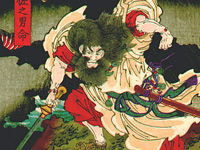
RESOURCES
This article uses material from the Wikipedia article "Yamata no Orochi (八岐の大蛇)", which is released under the Creative Commons Attribution-Share-Alike License 3.0.
© Stories Preschool. All Rights Reserved.
